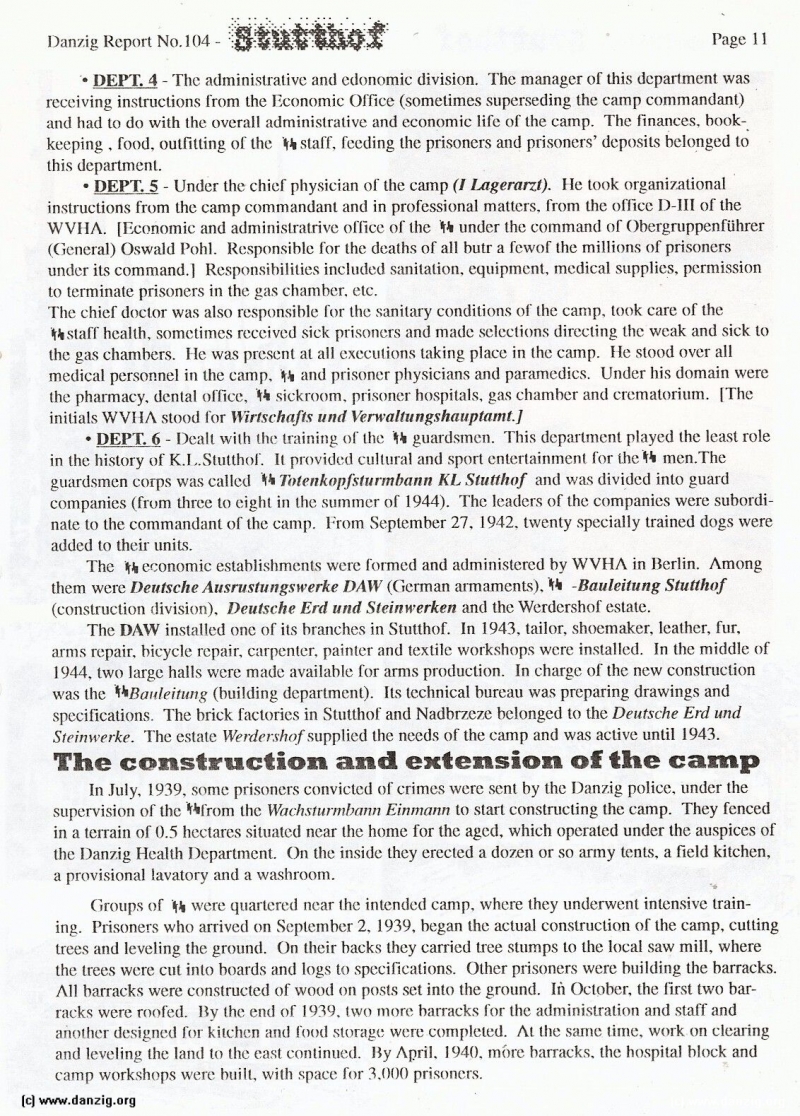
DEPT. 4 - The administrative an(l edonomic division. The manager of this department was receiving instructions from the Economic Office (sometimes superseding the camp commandant) and had to do with the overall administrative and economic life of the camp. The finances, bookk eeping . food, outfitting of the staff, feeding the prisoners and prisoners’ deposits belonged to this department.
DEPT, 5 - Under the chief physician of the camp (I Lagerarzt). lie took organizational instructions from the camp commandant and in professional matters. from the office 1)-Ill of the WVI1A. lEconomic and adminisiratrive olhce of the 4 tinder the command of ObcrgruppenfUhrer (General) Oswald PohI. Responsible for the deaths of all hutr a fewof the millions of prisoners under its command. 1 Responsibilities included sanitation. equipment. medical supplies, permission tO terminate prisoners in the gas chamber. etc.
The chief doctor was also responsible for the sanitary conditions of the camp. took care of the qstaff health, sometimes received sick prisoners and macic selections directing the weak and sick to the gas chambers. lie was present at all executions taking place in the camp. lie stood over all medical personnel in the camp. and prisoner physicians and paramedics. Under his domain were the pharmacy. dental ollice, 1 sickroom, prisoner hospitals. gas chamber and crematorium. IThe initials WVI IA stood for Ti irisehaft.s urn! Verwallungshauptaint.J
DEPT. 6 - l)ealt with the training of the guardsmen. This department played the least role in the history of K.LStutthoI. It provided cultural and sport entertainment for the men.The guardsmen corps was called Thtenkopj:cturrnhann KL Slutthof and was divided into guard companies (from three to eight in the summer of 1944). The leaders of the companies were subordin ate to the commandant of the camp. From September 27. 1942. twenty specially trained dogs were added to their units.
The economic establishments were formed and administered by WVHA in Berlin. Among them were Deutsche Au.srus(ungswerke PAW (German armaments). -Bauleitung Stutihof (construction division). 1)eutsche Erd und Stein werken and the Werdershof estate.
The DAW installed one of its branches in Stutthof. In 1943. tailor, shoemaker, leather, fur, arms repair, bicycle repair. carpenter. painter and textile workshops were installed. In the middle of 1944. two large halls were made available for arms production. In charge of the new construction was the 1Baii1eituiig (building department). Its technical bureau was preparing drawings and specifications. The brick factories in Stutthof and Nadhrzczc belonged to the Deutsche Erd und Steinwerke. The estate Werdeiwhof supplied the needs of the camp and was active until 1943.
The construction and extension of the camp
In July. 1939. some prisoners convicted of crimes were sent by the l)anzig police, tinder the supervision of the lrom the Wachstuimhann Einn,ann to start constructing the camp. They fenced in a terrain of 0.5 hectares situated near (he home for the aged. which operated under the auspices of the Danzig Health J)epartment. On the inside they erected a do7en or so army tents, a field kitchen. a provisional lavatory and a washroom. -
Groups of were quartered near the intende(1 camp. where they underwent intensive traini ng. Prisoners who arrived on September 2. 1939. began the actual construction of the camp. cutting trees and leveling the ground. On (heir hacks they carried tree stumps to the local saw mill, where the trees were cult into hoards and logs to specifications. Other prisoners were building the barracks. All barracks were constructed of wood on posts set into the ground. In October. the first two barr acks were roofed. By the end of 1939, two more barracks for the administration and staff and another designed For kitchen and food storage were completed. At the same tIITIC. work on clearing and leveling the land to (he east continued. By April. 1940. more barracks, the hospital block and camp workshops were built, with space for 3.000 prisoners.
Danzig Report Vol. 1 - Nr. 104 - July - August - September - 1999, Page 11.
Hits: 3499
Added: 25/07/2015
Copyright: 2025 Danzig.org

